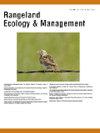利用苗期除草剂和深沟技术提高一年生牧草入侵地区的播种成功率
IF 2.4
3区 环境科学与生态学
Q2 ECOLOGY
引用次数: 0
摘要
外来的一年生杂草入侵并改变了北美西部的生态系统。对这些被入侵的遗址的恢复取得了低水平的成功。苗期除草剂可以有效地控制这些一年生杂草,但这种处理不允许同时播种所需的物种。在除草剂施用后的深u形沟内播种可能是一种通过在播种时将除草剂从种子转移开来减少苗期前除草剂效应的方法。我们通过在苗期前喷洒或不喷洒除草剂imazapic,然后播种或不播种深沟来研究这种方法。处理(即喷洒和犁沟)使用机械设备在六个地点进行一次处理。在无地平样地,深沟的植物密度和地上生物量普遍高于无沟样地。同样地,在有异氮的地块上,深沟通常改善了种子物种的测量植物指标。例如,施用imazapic的地块深沟密度比无沟处理高62 ~ 97%,未施用imazapic的地块深沟密度高41 ~ 89%。深沟在播种后的第一年也减少了外来的一年生杂草,但当这种处理与imazapic一起施用时,杂草减少通常更有效。总的来说,这项研究提供了证据,证明在大多数情况下,仅深沟就可以提高播种成功率。然而,在杂草覆盖率高的地区,应考虑将除草剂施用与深沟一次性结合使用。由于深沟会对土壤造成较大的扰动,因此应选择性地应用该方法,例如将处理限制在严重退化的地区。本文章由计算机程序翻译,如有差异,请以英文原文为准。
Improving Seeding Success in Annual Grass-Invaded Areas Using Pre-emergent Herbicide and Deep Furrowing Techniques
Exotic annual weeds have invaded and transformed western North American ecosystems. Restoration of these invaded sites has been met with low levels of success. Pre-emergent herbicides can effectively control these annual weeds, but this treatment does not allow for the concurrent seeding of desired species. Seeding within a deep U-shaped furrow following herbicide application may be a method to reduce pre-emergent herbicide effects by transferring the herbicide away from the seed at the time of planting. We investigated this method by spraying plots with or without the pre-emergent herbicide imazapic, then planting with or without a deep furrow. Treatments (i.e., spraying and furrowing) were applied using mechanical equipment within a single pass at six sites. In plots without imazapic, deep furrows generally had higher plant density and more above-ground biomass of seeded species than those in plots without furrows. Similarly, in plots with imazapic, deep furrows generally improved measured plant metrics for the seeded species. For example, plant density in deep furrows was 62–97% higher than that with nonfurrow treatments in plots with imazapic and 41–89% higher in plots without imazapic. Deep furrows also decreased exotic annual weeds in the first year after planting, but weed reduction was generally more effective when this treatment was applied with imazapic. Overall, this research provides evidence that deep furrows alone can improve seeding success in most instances. Nevertheless, combining herbicide application with deep furrows in a one-pass system should be considered in areas with high weed cover. Due to the substantial soil disturbance caused by deep furrows, this method should be selectively applied, such as constraining the treatment to substantially degraded areas.
求助全文
通过发布文献求助,成功后即可免费获取论文全文。
去求助
来源期刊

Rangeland Ecology & Management
农林科学-环境科学
CiteScore
4.60
自引率
13.00%
发文量
87
审稿时长
12-24 weeks
期刊介绍:
Rangeland Ecology & Management publishes all topics-including ecology, management, socioeconomic and policy-pertaining to global rangelands. The journal''s mission is to inform academics, ecosystem managers and policy makers of science-based information to promote sound rangeland stewardship. Author submissions are published in five manuscript categories: original research papers, high-profile forum topics, concept syntheses, as well as research and technical notes.
Rangelands represent approximately 50% of the Earth''s land area and provision multiple ecosystem services for large human populations. This expansive and diverse land area functions as coupled human-ecological systems. Knowledge of both social and biophysical system components and their interactions represent the foundation for informed rangeland stewardship. Rangeland Ecology & Management uniquely integrates information from multiple system components to address current and pending challenges confronting global rangelands.
 求助内容:
求助内容: 应助结果提醒方式:
应助结果提醒方式:


